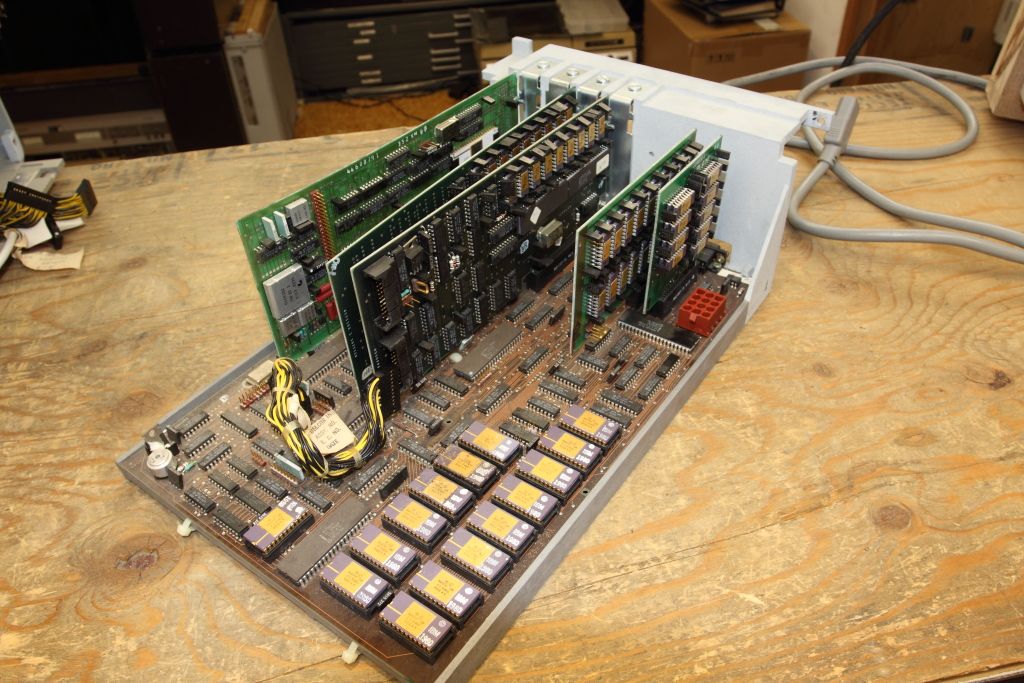I don't have any documentation other than what's already out there online. When I pulled it out of e-waste it only notable extra things it had was the original box (which was water damaged and not really worth saving), the two custom program disks the company that originally owned it used (Which still work), and the overlays for above the keyboard. I'm not sure if those are already out there, but I can scan them.
I didn't have to do any repairs on it. Other than some yellowed sticky gunk on the fan, probably from years of a minor amount smoking around it, the inside was in very good condition. Just dust, no corrosion or damage. Powering it up went smoothly, except for my son complaining about his ears from the flyback transformer.
I'm willing to dive in a help with any reverse engineering, though my hardware experience is only a bit above novice at best. I've got a soldering station and a multimeter myself and I have access to an oscilloscope, but I'm not very experienced in using it. I'm willing to disassemble, photograph, and test in any way requested, but for the testing I'll probably need to be walked through the process.
Honestly, I just really love the look and feel of this beast (especially that wonderful pre-Model F keyboard) and I'd love to have something somewhat useful to do with it. I had been searching as much as I could for the Word Processor for it, but after reading this thread I now know that it needed a card that I don't have.
One area of reverse engineering I think we should look into is the serial port it has. It would be great to be able to adapt it to standard RS-232 which would allow some kind of connectivity to more modern systems for data transfer. Personally the only 8-inch floppy drives I have access to are the ones in the Datamaster itself (though I have a whole lot of 8-inch floppies from my work that was going to e-waste them). So any software for it I would need to write myself or have someone image a disk using a shugart drive. Maybe a kryoflux or a greasewezel could be adapted to use the proprietary IBM drives as well.
Well let me know if there's anything specific you'd like me to do with my Datamaster.
Eager to start, aren't you? I can't blame you, I was in the same mood when the thing arrived.

So, you are collecting some computer history with your son? That's very relatable to my case, as my father and I have been for some years. If he complained from the CRT, it seems he is too yound to have known that type of screens... something similar happened on my side - when my father showed me his first computers (a Sinclair ZX-81 and a ZX Spectrum), I called him a liar because I thought those were just keyboards... it's been a long time ago though.
If you have the overlays, it should be worth scanning them for preservation.
I would like to use my System/23 for something else than occupying a bench. I would like to control a scale model train with one of my oldest computers (this one or maybe some PET). It's good that you want to achieve the same goal of giving it a purpose.
My skills in reverse engineering aren't the best either, but I have achieved the few things I have by persevering. I let you know, it's a risky process in which you could damage your board; therefore think it very well before acting. I learned many things during my process with the memories, but my board suffered damage I had to repair later. Still, having to pay that price was worth to me as the results I got enabled to repair other systems and provide some security to my own unit. If you do it, always balance the risks and consider it. The failures I induced by accident also gave me an insight on the behaviour of the system in certain cases. Have in account that If something bad happened while you were reverse-engineering, I would help you as much as I could to bring it back. After all the collected data has to serve this purpose of reparation.
About the floppy drives, we (my father and I) tried to enable unit 3. However, that's not an easy task. We considered the adaptation and usage of a gotek, but unfortunately the IBM format drives the magnets of the rotor directly from the controller board instead of having an enable and a direction signals. It won't be easy to have something working for some time.
Talking of the serial port, if you wanted I could give you some files that would help you guide through the board. There is still an unidentified component in the subsystem, I know it's an optocoupler, it's from HP and the timeframe it was in the market; the possibilities with that data and the number of pins left a small list from a Databook but only one will make sense the day its sorroundings are mapped. If you want to explore that area, I can help you.
Still, there are other things you could start with. Could you describe your model, please? If yours has 32KB or 96KB you must have a 32KB board. I reverse engineered the one of 64KB but as I don't have the 32KB one, I cannot study it. If you had other expansion cards other than the floppy controller, that would be worth noting.
Finally, I shall thank you for your decision to study it. Every contribution, for small as it can be, is important.
P.D. I work with Kicad. If you were to start documenting, which cad would you use?

